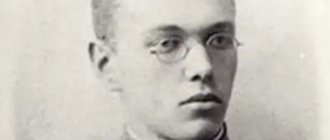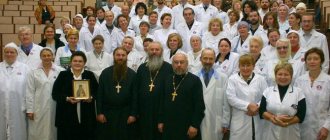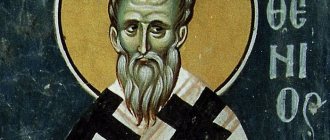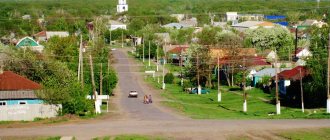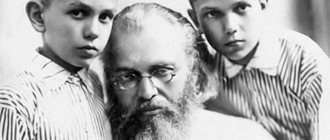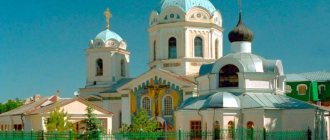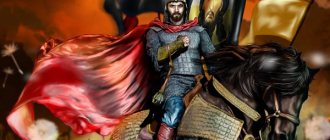He was revered long before church canonization. Believers and non-believers were equally grateful for the saved health and spiritual support during the earthly life of Archbishop Luke, a saint and doctor. An even greater number come to life physically and spiritually after the death of an ascetic - either at the relics, or simply by prayerfully turning to a quick and kind healer. Therefore, there is almost no church where there would not be his holy image, where special days in memory of Archbishop Luke of Crimea would not be celebrated.
St. Luka Krymsky
How did it happen that the memory of St. Luke (Voino-Yasenetsky) is celebrated several times a year
Valentin Voino-Yasenetsky, who grew up in a deeply religious family, wanted to be an artist since childhood. But, driven by the desire to help people, he chose the path of a doctor.
From his youth, his life credo was determined: “I do not have the right to do what I like, but I am obliged to do what is useful for suffering people.”
This impatience of someone else's suffering, pain nearby, the desire to immediately, immediately help, support, cure - perhaps the main feature, the basis of his entire life.
Useful materials
The long earthly journey of St. Bows are:
- service of a young doctor on the battlefields with Japan (1904-1905);
- the almost hard labor of a zemstvo doctor, a continuous stream of sick people day and night;
- There are many scientific works on medicine, many of them are classics.
Interesting fact
For example, thanks to Dr. Voino-Yasenetsky, local anesthesia appeared. And the work “Essays on Purulent Surgery” received the Stalin Prize in 1946.
By the time the doctor’s merits were recognized by the authorities, he was known not only as a physician, but also as a minister of the Church, a bishop. He became a priest after the death of his wife in 1921. And after another 2 years, Father Valentin became a hieromonk with the name of the doctor Luke, the Evangelist. Then - Bishop of Tashkent and Turkestan.
What about medicine? Yes, everything is the same - operations, night shifts. Only with a large cross on the chest, under the robe - a cassock. This did not go unnoticed. A short time after his episcopal consecration, he was arrested for the first time.
Then Vladyka spent more than 10 years in prisons and camps. The bishop himself wrote: there were moments of despondency, even murmur. But in all his suffering he felt the presence of God. The Lord helped not only to survive, but also not to become embittered.
When the war began in 1941, the saint himself asked to work in a hospital where his surgeon’s hands were so needed. So “Professor Voino-Yasenetsky” became the head physician of the hospital for wounded soldiers in Krasnoyarsk. Hundreds of saved lives, brilliant operations. The authorities even turned a blind eye to the fact that the exiled bishop simultaneously became the Bishop of Krasnoyarsk (1942).
Then there was the same work - and the episcopal see - in Tambov. The last place of service of St. Luke - Simferopol. Here, in his beloved Crimea, where the saint spent his childhood, his relics have resided since 1961. And they venerate St. Luke throughout the country, especially where the ascetic had been in exile, worked, and treated. His name is among the especially revered saints of several metropolises of the Russian Church. That is why there are many days in memory of the saint.
"Crimean Wonderworker of the 20th century." Saint Luke (Voino-Yasenetsky). Church calendar for June 11
The main church holidays, days of remembrance of saints and Orthodox shrines of today.
June 11 (May 29 according to the “old style” - the church Julian calendar). Friday of the 6th week of Easter (sixth week after the Holy Resurrection of Christ ). It is a fast day fish is blessed at the meal . Today is the post-celebration of the great twelve feast of the Ascension of the Lord , a celebration in honor of two shrines and the memory of eight saints. Next we will briefly talk about them.
* * *
Saint Luke (Voino-Yasenetsky), Archbishop of Crimea . This great archpastor and confessor is one of the most famous and revered saints of the 20th century . A brilliant surgeon who received an excellent education at Kiev University, at the beginning of his ministry the future saint deliberately went to the outback as a simple zemstvo doctor. Having endured many sorrows, including the death of his beloved wife, he did not become embittered, but, on the contrary, decided to devote his life to God. Saint Luke received his priestly ordination, and then monastic tonsure and the rank of bishop during the years of the most severe anti-church persecution, when such a choice meant a death sentence. The Lord saved the saint from death, but he had to endure a lot of torment in prisons, camps and exile.
He never renounced his rank and, even when during the Great Patriotic War , freed from exile, he became the chief surgeon of the Krasnoyarsk evacuation hospital, he always performed surgical operations with prayer. Subsequently, for his labors, the saint-surgeon was awarded the medal “For Valiant Labor in the Great Patriotic War,” and for his scientific works he was awarded the Stalin Prize. Saint Luke spent the last years of his life in Crimea, where he cared for the local diocese in the difficult conditions of Khrushchev’s persecution of the Church. The bishop died in 1961 .
The venerable relics of this great Christian ascetic the 20th century were found in 1996 and have since rested in the Holy Trinity Monastery of Simferopol, where hundreds of believers from all over the world turn to them every day with their sorrows and needs and through his prayers receive help and healing (providential fact: 18 years later on the same day, Crimea, whose Heavenly patron is St. Luke, reunited with Russia).
* * *
Venerable Martyr Theodosius of Constantinople . One of the host of sufferers for the veneration of holy icons who died at the hands of heretical iconoclasts in the 8th century . Nun Theodosia was raised and then took monastic vows in the Constantinople monastery, where she became famous for her meekness, prayerfulness, and also for spending her parental inheritance on painting images of saints.
In 730 from the Nativity of Christ, when the false patriarch-iconoclast Anastasius committed a desecration of one of the icons of Constantinople, Theodosia stood up in defense of the shrine, for which she was imprisoned, and then, after much bullying and torment, killed.
Venerable Martyr Theodosius of Constantinople. Photo: pravoslavie.ru
Venerable John of Ustyug, blessed fool for Christ's sake . One of the many Russian medieval saints who voluntarily took upon themselves the feat of foolishness and imaginary madness for the sake of openly preaching the Word of God and exposing vices. Saint John was a strict faster and ascetic, he practically did not sleep, and spent his nights in prayer. Even during his short, 18-year earthly life, he became famous for his miracles. He rested in 1494 from the Nativity of Christ, after which numerous miracles also began to be performed through the prayers of this saint. Among other things, it was Saint John who helped Russian troops defeat the Polish-Lithuanian invaders near the city of Dmitrov in 1610 .
Saints Procopius and John of Ustyug. Photo: pravoslavie.ru
Venerable Job, in the schema of Jesus, Anzersky . Ascetic of the second half of the 17th – early 18th centuries . It was a difficult time for the Russian Church, first torn apart by the Old Believer Schism, and then deprived of the patriarchate and subordinated to the state under Peter I. At one time, the future saint was close to the tsar and even served as a court confessor, but in 1701 he was slandered and exiled to the Solovetsky Monastery. At the monastery, despite his advanced age, Father Job showed himself to be a tireless worker and man of prayer. The monks greatly revered the priest, who in his old age accepted the great schema (the deepest degree of renunciation of the world). The monk died in 1720 .
Transfer of the relics of the martyr Theodosia of Tire . We are talking about the transfer of the relics of one of the early Christian martyrs who suffered during the persecution around 307/308 from the Nativity of Christ. The holy remains of the sufferer for Christ were transferred to Constantinople, and then to Venice at a time when the Western Church had not yet moved away from Orthodoxy.
Memory of the First Ecumenical Council . Ecumenical councils are the most important institution for making key church decisions in matters of developing Orthodox dogma, that is, the basic foundations of Christian theology. Only conciliar decisions adopted by the entire church (with the participation of bishops, lower clergy and ordinary laity) can be considered doctrinal. In the history of the Orthodox Church there have been 7 Ecumenical Councils. The first of them was convened by the Equal-to-the-Apostles Emperor Constantine the Great in the city of Nicaea in 325 AD . Among the participants of the cathedral were such great saints as Nicholas the Wonderworker and Spyridon of Trimythous. At this council, the Arian heresy was condemned, which rejected the consubstantiality of Christ with God the Father and, accordingly, belittled the Divinity of the Savior.
Also on June 11, the memory of two saints, glorified in the host of new martyrs and confessors of the Russian Church, is celebrated. Protodeacon John of Preobrazhensky and Andrei Trofimov , hieromartyr and martyr who suffered during the years of Soviet atheistic persecution in 1938 . In addition, June 11 is the day of several miraculous images of the Blessed Virgin Mary - icons of the Mother of God, called “Support of Sinners”, “Watching Eye”, “Softening Evil Hearts” and “Unbreakable Wall” . Each of them, through prayers before this image to the Heavenly Lady, is known for its help in many problems and troubles. Their figurative names only symbolically show that the Mother of God can be prayed for to soften evil hearts, to preserve the home unharmed, and for much more.
* * *
Congratulations to Orthodox Christians on the day of these shrines and the memory of all today's saints! Through their prayers, Lord, save and have mercy on us all! We are happy to congratulate those who received names in their honor in the Sacrament of Holy Baptism or in the rank of monastic tonsure! As they used to say in Rus' in the old days: “For the Guardian Angels - a golden crown, and for you - good health!”
To our departed relatives and friends - eternal memory!
What date is the saint's birthday?
The saint's biographers call his birthday April 27, 1877, or May 9 according to the new style. The Julian calendar, previously used in Russia, “lags” behind modern chronology by 13 days. Therefore, sometimes confusion occurs: the birth dates of the saint are called April 14 or May 10 of the new style, which is erroneous.
The days of memory of the saint are exactly milestones in his path as a doctor and a Christian. Here he worked for all the doctors at once, defeated typhus there, performed a unique operation. And most importantly, everywhere, he was always a believer who did not hide his convictions. Therefore, he is not just a doctor, but one through whom the Lord performed miracles of healing the body and soul.
Natalya Sazonova.
History of the holiday and traditions
Luke is an apostle from the seventy, a companion of the Apostle Paul, a Christian saint, revered as the author of one of the four Gospels and the Acts of the Holy Apostles. He was a doctor (Col. 4:14), possibly a ship's doctor. Evangelist Luke in the Orthodox and Catholic traditions is considered the first icon painter and patron saint of doctors and painters. The symbol of the Evangelist Luke, borrowed from the prophecy of Ezekiel, is a winged calf holding the Gospel.
The celebration of Lelnik is a special ceremony held on May 5, the main participants of which were girls. They dressed up in the best sundresses, danced around the blossoming apple trees and sang songs. It was believed that this is how the girls “cherished” the coming spring and fine weather. In addition, with the help of such a ritual, girls sought the favor of one of the ancient Slavic goddesses Lelya, who in return made their beauty unfading, and gave those who wished the happiness of a speedy, prosperous motherhood.
After leading a round dance near the apple trees, the most beautiful one was chosen among the girls, she was called “Lala”. The girl was decorated with ribbons, wreaths of fresh greenery and flowers and seated in the middle of the clearing on a bench. Then round dances began around the chosen Lyalya. All this action ended with the boys joining the girls, singing funny songs and dancing and jumping over the fire.
During summer time, not only girls had fun, but also evil spirits. The witches spread a white canvas on the grass and danced naked on it. The people believed that by this day the unclean ones were already pregnant. If a woman wanted to conceive a child, she had to go to a forest clearing, undress and quietly stand in the circle of witches. However, many were afraid that in this way the witch could throw her child into the woman’s womb. The leader of all this evil was considered the most cunning devil - Luka-Lukanka.
The name of St. Luke is also reflected in agriculture. On May 5, onions were planted in the beds: “Onions are like a Tatar: as soon as the snow melted, so they are here.” This plant was considered medicinal in Rus' - and for good reason; later its properties were confirmed by doctors. They said about onions: “Onions cure seven diseases”; “Whoever eats onions is freed from eternal torment”; “A bow and a bath will fix everything.” Onions were included in many folk medicines. In combination with honey, for example, it was used as a remedy for flu and atherosclerosis.
It was impossible to imagine Russian cuisine without onions. Onions were actively used in many dishes. It perfectly complemented soups, salads, appetizers, and was suitable for preparing various dishes - it was added to meat, fish, vegetables, and could be used as the main ingredient for main courses. It was also eaten raw - with salted fish and bread. “The onion is good both in battle and in cabbage soup”; “Holo-golo, but there is an onion in the cabbage soup,” people said.
Luka Krymsky - akathist
The very concept of “akathist” implies singing of praise - gratitude to the saint. In order to perform the akathist to Saint Luke, you must:
- Read the prayer while standing in front of the icons.
- Abstract from external problems and thoughtfully read the akathist.
- Think about the good and tune in to the best, in this case Archbishop Luke of Crimea will definitely be able to help.
- It’s good if relatives lament an akathist and a prayer for the health of a sick person.
Luke Krymsky - prayer
Even during his lifetime, Saint Luke of Crimea always helped people, regardless of their rank, and boldly promoted his faith. He continues to help people even now. To pray to the saint, it is advisable to have an icon with his image at home and place it in the “red corner”. Followed by:
- Light church candles.
- Girls and women should cover their heads.
- Stand facing the icon.
- Repeat three times: “Lord, have mercy” and cross yourself.
- Read the prayer thoughtfully, comprehending every word.
- Bow and cross yourself.
Signs
- If it freezes on Luka at night, then another forty morning frosts will fall on the grain fields.
- If the bird cherry blossoms early, then the summer will be warm. However, it should soon get colder, and “bird cherry cold” will set in.
- If the rowan tree has bloomed, the heat will be persistent.
- The cuckoo crowed - the frost will stop.
- If it’s a clear morning on Luke’s day, then it’s time to sow; if it’s foggy, you need to wait. At noon it will clear up - the sowing will be average, by the evening - late.
- The early moon promises early frosts, and you need to sow onions early in order to harvest the crop on time. If the moon is detrimental, it is better not to rush into sowing.
- It is dangerous for those born on May 5 to walk alone in the forest. They should wear sapphire.
Prepared based on information from open sources
Orthodox saints named Luke
Memorial dates are indicated according to the new style.
- Luke, St. July 10
- Luke April 21
- Luke, apostle see: Luke (Luke), apostle of the 70, bishop, Laodicea January 17, September 23
- Luke (Voino-Yasenetsky), Spanish, Archbishop, Simferopol February 8, June 11
- Luke, bishop, Novgorod February 23
- Luke, bishop, Novgorod June 28
- Luke of Bulgaria, St. August 31
- Luke of Babylon, Cordula, schmch., deacon August 12
- Luke of Valaam, martyr. 5th of March
- Luke Glubokorechensky (Cappadocia), abbot September 20
- Luke the Evangelist, smch. January 17, May 5, July 3, October 31 (author of the book of the Acts of the Holy Apostles, icon painter)
- Luke of Greece, hermit February 20
- Luke Mytilinsky, martyr, Swedish May 7
- Luke of Mytilene, Athos, martyr. 5th of April
- Luka Pechersky, economy October 11, November 19
- Luke the Stylite, Chalcedonian, hieromonk December 24
- Luke of Tauromenia, St. November 19
- Luke of Triglia, St. January 9
- Luke of Emesa (Yemissky), schmch., deacon February 11
Story
The Monk Luke (896–953) was from Kastoria (Ermioni). He adhered to strict asceticism in everything that concerned him personally, and also showed generous benevolence towards others. He was known as a spiritual mentor, although he did not have clergy.
Luca was born into a poor family and was forced to work hard since childhood. In my youth I prayed a lot. After the death of his father, he went to a monastery in Athens without telling his mother about it. There he took monastic vows and became a monk. The Lord, through the prayer of his yearning mother, returned Luka to his father’s house. After 4 months, with her blessing, he went to Mount John, to the Church of Cosmas and Damian, to find solitude. There he took monastic vows, and the Lord endowed him with the gift of insight and healing of mental and physical illnesses.
After 7 years, Saint Luke left Mount John and went to Corinth. For 10 years he obediently and humbly served the ascetic in Patras. Then he returned to his homeland again. Together with his student, he settled in Kaoavia, and 3 years later - on the island of Ampil.
Luke found peace only in Styria (Stirida). Here, together with his brethren, he built a small monastery. In his monastery he was engaged in good deeds - he healed the sick from mental and physical torment. He died in his cell. His relics exuded myrrh and healed the sick.
At the burial site of St. Luke, the construction of a church began in 974 (the building has survived to this day).
What not to do on February 20
- You cannot hold noisy events, loud holidays with fun, songs and dances. A bad sign, to troubles, you can attract dark forces into your home.
- You cannot make purchases or make any acquisitions - the purchase will be extremely unsuccessful. Moreover, it is better to refuse to buy food in reserve. You can only buy products that will be consumed or used in dishes right away, otherwise they will spoil.
- Women today are not allowed to wear green clothes - there could be trouble. According to another sign, a woman who puts on green things will have to yearn alone.
- You can't drink tea - it will take your strength. Instead of tea, they drank herbal infusions, compotes, and so on.
- You cannot have a wedding - the marriage will not last long, and one of the spouses may cheat.
- A woman is not recommended to leave the house unless absolutely necessary - she may get into a bad situation and encounter troubles.
- You cannot raise a defensive cross by someone. If you pick up someone else's cross, you can take away the sorrows, problems and illnesses of the person who lost it.
Luke of Crimea - icon
In the holy image of Luke, he stands with his hand raised, dressed in a robe, thereby blessing the believers. Luke of Simferopol is sometimes depicted with a book sitting at a table. The icon of St. Luke is placed in hospitals so that the sick can pray for healing. Its significance for believers is very great. Luka Krymsky became a Russian miracle worker, helping in all life’s difficulties.
What not to do on St. Luke the Hungry Day
- On the feast of Luke, according to legend, you cannot play weddings or arrange matchmaking.
- It is strictly forbidden to count supplies for the upcoming season.
- On St. Luke's Day, October 31, 2022, believers must not remember or talk about people who are no longer alive.
- You cannot lend money, water or bread to anyone.
- To avoid losses, it is prohibited to leave your shoes on a chair or on a table.
- Dolls should not be given as gifts to little girls - according to popular belief, this can lead to infertility.
- You cannot brag about your health and material wealth.
Prayer to Saint Luke
O holy servant of God, Apostle Luke! Having fought a good fight on earth, you have received in Heaven the crown of righteousness, which the Lord has prepared for all who love Him. In the same way, looking at your holy image, we rejoice at the glorious end of your life and honor your holy memory. You, standing before the Throne of God, accept our prayers and bring them to the All-Merciful God, to forgive us every sin and help us against the wiles of the devil, so that, having been delivered from sorrows, illnesses, troubles and misfortunes and all evil, we will live piously and righteously in the present We will be worthy through your intercession, even though we are unworthy, to see good on the land of the living, glorifying the One in His saints, the glorified God, the Father and the Son and the Holy Spirit, now and forever. Amen.
Subject:
- Holidays
